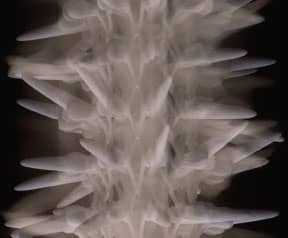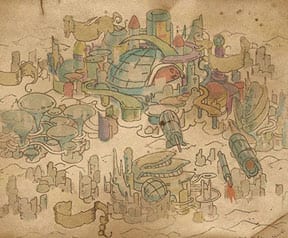ARS ELECTRONICA
in the KNOWLEDGE CAPITAL vol.07


Since the emergence of IoT and digital fabrication, manufacturing is no longer a unilateral process exclusive to industries, but more an interactive process in which each of us can participate and collaborate to develop ideas in society.
InduSTORY reveals the stories of two groups of creators who challenge the conventional concept of design and manufacturing: вҖҳPrototyping & Design LaboratoryвҖҷ run by Prof. Shunji Yamanaka at The University of Tokyo explores the potentiality of novel artifacts through prototype integrating design and engineering, вҖҳneurowearвҖҷ deftly transforms new ways of human-machine relationships into IoT devices that fit naturally into our lifestyles.
Through their STORYs, you can witness how Industry changes, and will be able to get a glimpse of our future.
Participating artists

neurowear is a project team based in Tokyo, focused on creating "communication for the near future" since fall 2010. It proposes novel design for the human-things relationship, utilizing sensor and data, such as biological signals (brain waves, heartbeat, etc.), though prototypes and concept movies. Their вҖңnecomimiвҖқ was selected as the Honorary Mention in the Interactive Art category, Prix Ars Electronica 2013.
http://neurowear.com
-
 Kana Nakano neurowear
Kana Nakano neurowear
Creative Technologist / Communication Planner
Working at DENTSU since 2009. After her career at internet ad agency, she designs and develops unique user experience integrating technology and novel style of communication. Her recent project "iButterfly" combines AR (augmented reality) with location-based voucher app.
-
 Tomonori Kagaya neurowear
Tomonori Kagaya neurowear
Director / Planner
He engages himself in variety of start-up projects in the field of digital network as a freelancer. Expertise in team management, concept planning and research and development in new business domain. Noted projects: windVibe (w/Ryuichi Sakamoto, musician), GEOCOSMOS at Miraikan.
 © Photo by Shinsuke Yasui
© Photo by Shinsuke Yasui
mononome(2014)
neurowear Г— Aizu Laboratory, Inc.
Named after the Japanese for вҖңeyes of thingsвҖқ, the eye-shaped device equipped with a sensor is attached to furniture and home electronics and monitors the activities of objects. When the furniture is moved, the eye expressions change and the activities are recorded. The eyes are a natural user interface that can reveal the userвҖҷs habits and even allow the objects to convey a message to its users, like вҖңTake your medicine on time!вҖқ The artist has developed new communication methods between humans and objects that will enrich the quality of life.
 © Photo by Shinsuke Yasui
© Photo by Shinsuke Yasui
COTOREES(2016)
neurowear Г— tsug.LLC
COTOREES is a cute bird-like wireless computer that is controlled by voice. Not too smart, but just like a pet that reacts when you talk to it. They cannot do everything, but each character has one specific function: The вҖҳWeather birdвҖҷ tells you todayвҖҷs weather on a busy morning, вҖҳTrans-birdвҖҷ translates a simple sentence for you, вҖҳWiki-birdвҖҷ tells you the meaning of words, like a dictionary. Mobile apps have appeared in the real world. What other type of вҖҳbirdвҖҷ would you like?

Onigilin (2016)
neurowear Г— STARRYWORKS inc.
The device helps you control the three key elements for meditation (body tone, breathing rate, heart rate), making it easy for anyone to start meditating with ease. The rice-ball (onigili in Japanese) shape has easy portability so you can give your heart and mind a light workout on your way to work or while at your desk.

The laboratory is led by Prof. Shunji Yamanaka, the visionary design engineer who has been researching the relationship between human and things. Members introduce industrial design methodology into advanced engineering fields such as robotics and aeronautics, develop prototype utilizing leading-edge technology, and research possibilities of future artifacts from both designing and engineering aspects.
http://www.design-lab.iis.u-tokyo.ac.jp/

Prof. Shunji Yamanaka
 © Yukio Shimizu
© Yukio Shimizu
Flagella (2009)
Shunji Yamanaka, Yusuke Kamiyama, Mitsuru Muramatsu, Keio University SFC Yamanaka Design Laboratory
Flexible robotic arms move without touching each other. Inspired by the unique organism flagellum, which has a rotary motor at its base, the tube-shaped rigid structures deftly twist in several sections of the arms, powered by a servomotor that turns clockwise or counter-clockwise. The simple structure realizes fluid and dynamic motion that reminds us of intellectual living creatures.
Cooperation by NICHINAN CORPORATION
 © Yasushi Kato
© Yasushi Kato
Apostroph (2014)
Mitsuru Muramatsu, Manfred Hild (Beuth Hochschule fГјr Technik Berlin), Shunji Yamanaka
Prototyping & Design Laboratory, The University of Tokyo
A prototype of a robot designed to study the intrinsic behaviors of living organisms. In Apostroph, the joint contains motors that are programmed to resist external force. These motors rotate in the opposite direction to gravity rotation. Consequently, Apostroph tries to lift its body, in the same way as a human being stands up. Instead of precise control of the whole structure, simple but vital control achieves high resiliency.
Cooperation by Aspect, Inc.
 Upper two photos:© Yasushi Kato
Upper two photos:© Yasushi Kato
READY TO CRAWL (2015)
Hiroshi Sugihara, Shunji Yamanaka Prototyping & Design Laboratory, The University of Tokyo
Bio-like robots made by 3D printing. Machines are usually completed by assembling parts that are manufactured in different ways from different materials. In additive manufacturing (AM) it is possible to make several parts in an assembled state as one machine. This project aimed to make robots that were born in a completed state by making all of the parts, excluding a DC motor, assembled by AM as one machine. It shows the possibility of вҖңthe Design of MotionвҖқ in 3D printing, which reverses the current method of designing; not integrating components to realize a movement, but designing movements first then finding/developing/creating the best shape to achieve the movements.
 © Yasushi Kato
© Yasushi Kato
Structured Texture (2015)
Satoshi Tanigawa, Panasonic Corporation, Prototyping & Design Laboratory, The University of Tokyo
Nylon-made group of objects printed by 3D printing. Research aims to achieve different tactile sensations from objects of the same material, by changing their structural composition. When people take the artworks in their hands, human perception of heaviness, tenderness, and texture undergoes an interesting surprise. The shape of the lizards you find in READY TO CRAWL was inspired by this study.

Ars Electronica is a cultural institute for media arts, located in Linz, Austria.The Ars Electronica is consisted of 4 departments of вҖңArs Electronica FestivalвҖқ for art, technology and society held in every September,вҖңArs Electronica CenterвҖқ as museum of the future, вҖңPrix Ars ElectronicaвҖқ international completion for media arts and вҖңArs Electronica FuturelabвҖқ as R&D function. Also many Japanese creators participates in their activities.
Ars Electronica : http://www.aec.at/

photo: Nicolas Ferrando,Lois Lammerhuber
Guests for Special program
-
 Martin Honzik (AT)
Martin Honzik (AT)
Director of the Ars Electronica Festival. Every year, he features a different part of the City of Linz and creates a festival with a focus on the interaction of city dwellers and urban spaces.
-
 Shoko Takahashi (AT/JP)
Shoko Takahashi (AT/JP)
Researcher, Ars Electronica Futurelab. After working as a product planner of automotive and humanoid robots, she joined Futurelab to lead projects on new technology implementation.
















